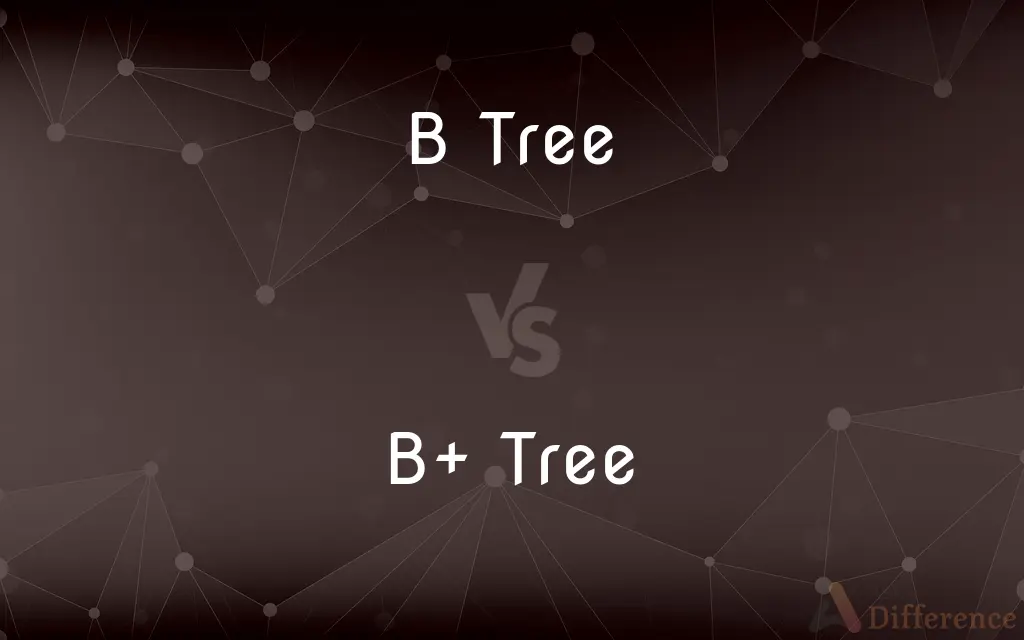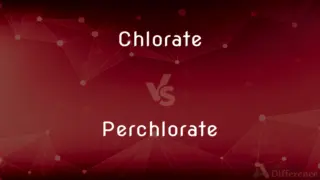B Tree vs. B+ Tree — What's the Difference?
Edited by Tayyaba Rehman — By Fiza Rafique — Published on November 10, 2023
B Tree is a balanced tree data structure with sorted data at all nodes, while a B+ Tree is a variation where only the leaves contain data and the internal nodes hold keys to guide search.

Difference Between B Tree and B+ Tree
Table of Contents
ADVERTISEMENT
Key Differences
In the realm of computer science, both B Tree and B+ Tree emerge as essential tree data structures, used primarily in databases and filesystems. The B Tree is characterized by its ability to maintain sorted data across all its nodes. This ensures efficient insertions, deletions, and look-ups, as the tree remains balanced after each operation. The B+ Tree, conversely, is a refined version of the B Tree. It differentiates itself by storing data only at the leaf level, while its internal nodes simply guide the search operations with keys.
Elaborating further, the B Tree's versatility is evident as it stores data within both internal nodes and leaf nodes. This feature offers some advantages in certain scenarios, as data can be accessed at multiple points. The B+ Tree, on the other hand, concentrates all data at the leaves. This ensures a uniform depth for data retrieval, potentially leading to more consistent search times. Additionally, the leaves in a B+ Tree are linked, making range queries more efficient.
The structure of the B Tree provides flexibility in accessing data. As data exists in both the internal and leaf nodes, certain search operations might conclude before reaching the leaves. The B+ Tree, while presenting a more specialized structure, optimizes range-based operations. With all data aligned at the leaf level and linked, it enables efficient sequential access.
Summarizing, while both the B Tree and B+ Tree are foundational structures in computer science, they cater to slightly different use cases. The B Tree offers a generalized approach with data spread throughout, whereas the B+ Tree, with its data-centric leaves, provides optimization for specific scenarios, particularly range queries.
Comparison Chart
Data Storage
Data stored in both internal and leaf nodes.
Data stored only at leaf nodes.
ADVERTISEMENT
Leaf Nodes
Do not have links to neighboring leaves.
Linked together for efficient sequential access.
Efficiency
Diverse scenarios due to data in all nodes.
More consistent search times and better range queries.
Depth of Data Retrieval
Varies as data is present in both internal and leaf nodes.
Uniform, as data exists only at the leaves.
Structure Purpose
Generalized data access and balanced tree maintenance.
Optimized for scenarios requiring efficient sequential data access.
Compare with Definitions
B Tree
A structure optimizing search, insert, and delete operations by maintaining tree balance.
After inserting an element into a B Tree, the tree adjusts to remain balanced.
B+ Tree
A structure where all leaf nodes are at the same level, ensuring data depth uniformity.
B+ Trees guarantee that data retrieval requires a consistent number of steps.
B Tree
A tree that divides its keys into multiple nodes to enable efficient database operations.
Databases employ B Trees to speed up data retrieval processes.
B+ Tree
A tree data structure where data is present only at leaf nodes, optimizing search.
The B+ Tree's design ensures consistent search depths.
B Tree
A tree where each node contains a certain range of keys and optional associated values.
In a B Tree, nodes can have multiple keys directing the search path.
B+ Tree
A balanced tree structure specializing in database and filesystem indexing.
Filesystems utilize B+ Trees due to their efficient data access patterns.
B Tree
A tree where nodes have multiple children, determined by the tree's order.
Given its order, a B Tree ensures each node has a specified range of children.
B+ Tree
A tree segregating keys (internal nodes) and actual data (leaf nodes).
In a B+ Tree, internal nodes guide the search to the appropriate data leaf.
B Tree
A self-balancing tree data structure maintaining sorted data in all nodes.
The B Tree ensures quick data access due to its balanced nature.
B+ Tree
A variation of B Tree with linked leaves to streamline sequential access.
The B+ Tree is favored in systems where range queries are frequent.
Common Curiosities
Are all leaves in a B+ Tree at the same depth?
Yes, all leaves in a B+ Tree are at a uniform depth.
Can a B Tree be used for database indexing?
Yes, both B Trees and B+ Trees are used in database indexing.
What ensures the balance in a B Tree?
Insertion and deletion operations in a B Tree involve splits and merges to maintain balance.
Why might one prefer a B+ Tree over a B Tree?
B+ Trees offer more consistent search times and optimize sequential data access.
How does a B+ Tree enhance range queries?
In B+ Trees, leaf nodes are linked, making it efficient to traverse a range of data sequentially.
What does the "B" in B Tree and B+ Tree represent?
It's generally considered to represent "Balanced," but original definitions vary.
Are B Trees always balanced?
Yes, B Trees remain balanced after every insert or delete operation.
What's the core distinction between B Tree and B+ Tree?
B Tree stores data in all nodes, while B+ Tree stores data only in leaf nodes.
How are deletions managed in a B+ Tree?
Through merging or redistributing keys, ensuring the tree remains balanced.
How do B Trees handle node overflows?
By splitting the node and redistributing keys.
Are B Trees and B+ Trees binary trees?
No, they can have more than two children per node, determined by their order.
Why do B+ Trees link their leaf nodes?
To enhance sequential data access, especially beneficial for range queries.
Do B+ Trees require less disk I/O than B Trees?
Often, yes, because B+ Trees concentrate data at the leaves, often leading to fewer disk reads.
Is the height of a B Tree and B+ Tree always logarithmic to the number of entries?
Yes, ensuring efficient operations.
Which tree structure is more space efficient?
B+ Trees can be more space efficient in scenarios where the overhead of pointers in internal nodes is less than storing actual data.
Share Your Discovery

Previous Comparison
Disney Fastpass vs. Fastpass Plus
Next Comparison
Chlorate vs. PerchlorateAuthor Spotlight
Written by
Fiza RafiqueFiza Rafique is a skilled content writer at AskDifference.com, where she meticulously refines and enhances written pieces. Drawing from her vast editorial expertise, Fiza ensures clarity, accuracy, and precision in every article. Passionate about language, she continually seeks to elevate the quality of content for readers worldwide.
Edited by
Tayyaba RehmanTayyaba Rehman is a distinguished writer, currently serving as a primary contributor to askdifference.com. As a researcher in semantics and etymology, Tayyaba's passion for the complexity of languages and their distinctions has found a perfect home on the platform. Tayyaba delves into the intricacies of language, distinguishing between commonly confused words and phrases, thereby providing clarity for readers worldwide.












































